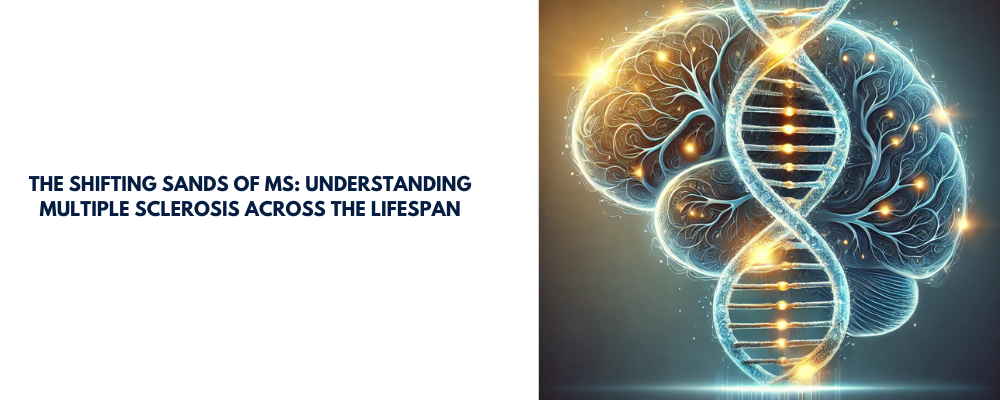The Shifting Sands of MS: Understanding Multiple Sclerosis Across the Lifespan

Multiple sclerosis (MS) is a disease that many people associate with young adults, but the reality is far more complex. While it's true that MS often appears between the ages of 20 and 40, it can also emerge in childhood (pediatric-onset MS or POMS) or later in life (late-onset MS or LOMS). This article dives into how age at onset impacts the way MS develops, how it's treated, and what challenges patients face at these different stages.
Two Sides of the Same Coin: POMS and LOMS
The article highlights the distinct nature of POMS and LOMS, demonstrating that MS is not a one-size-fits-all condition.
* Pediatric-Onset MS (POMS): This refers to MS that begins before the age of 18.
* It's often characterized by a more aggressive start with more relapses. This might sound scary, but interestingly, children and adolescents with MS often experience better recovery from these relapses.
* Early axonal damage is more pronounced in POMS, meaning that the nerve fibers can be affected early on.
* It can be difficult to diagnose because it can mimic other childhood disorders.
* It is more common for children to have a relapsing-remitting (RR) course of the disease compared to adults.
* Genetic and environmental factors such as the Epstein-Barr virus (EBV) and obesity play a significant role in the development of POMS.
* Digital technologies are emerging as useful tools for therapy and monitoring, as younger patients are more familiar with technology.
* Engagement is critical, it's important that children and their families understand the disease and feel involved in making treatment decisions.
* Unmet Needs: There's a real need for more information, support, and understanding of how MS affects children and adolescents.
* Late-Onset MS (LOMS): This refers to MS that begins after the age of 50.
* LOMS patients are more likely to have a progressive form of MS and experience chronic axonal loss due to natural aging.
* Hormonal changes and pollution may act as triggers for LOMS.
* The diagnosis can be more complex due to overlapping symptoms with other age-related neurological issues and comorbidities.
* Immunosenescence, the aging of the immune system, is a major factor in LOMS and can lead to increased inflammation, reduced efficacy of treatments, and a higher risk of infection.
* There is a lack of data on the safety and efficacy of disease-modifying treatments (DMTs) in older individuals.
The Role of Genes and Environment
The article emphasizes that both POMS and LOMS are likely caused by a combination of genetic susceptibility and environmental factors.
* Genetics: Specific gene variations, such as HLA-DRB1*15:01, are associated with increased risk of developing MS in both childhood and adulthood.
* Environment:
* In POMS, childhood obesity, low levels of vitamin D, and viral infections, particularly EBV, are recognized as risk factors. The EBV virus has been identified as a major cause of MS.
* In LOMS, air pollution, hormonal changes, chronic inflammation, and oxidative stress are associated with increased risk.
Treatment and Engagement: Different Strokes for Different Folks
The management of MS is highly individualized, and this is especially true for POMS and LOMS patients.
* POMS: Early treatment with disease-modifying therapies (DMTs) is recommended to reduce relapses and disability. Newer oral DMTs have shown promising results in managing POMS, though long-term safety data are still needed. Digital technologies have emerged as useful tools in therapy and monitoring.
* LOMS: Treatment is challenging due to the increased risk of side effects and reduced efficacy of DMTs due to immunosenescence. Discontinuation of DMTs is also a complex issue as it may lead to disease worsening. However, recent studies suggest that minimal new disease activity after stopping treatment may be acceptable. Shared decision making between patient and neurologist is essential for treatment choices.
The Importance of Patient and Caregiver Engagement
Across all age groups, active involvement of the patient and their caregivers is vital for effective disease management. This includes clear communication, personalized advice, and access to a multidisciplinary support team, including neurologists, psychologists and nurses. It also means engaging in shared decision-making around treatment options.
The Promise of Digital Innovation
The article highlights the potential of digital tools to revolutionize MS care, especially for POMS patients. These tools can be used for:
* Monitoring symptoms
* Providing rehabilitation
* Improving communication between patients and healthcare providers
* Facilitating self-assessment and patient engagement
Conclusion: A Lifespan Perspective on MS
MS is a complex disease that manifests differently at different ages. Understanding the specific challenges and needs of POMS and LOMS patients is crucial to providing appropriate care. As research progresses, it is expected that treatments will become more tailored to specific age groups, which will hopefully improve the quality of life for all people living with MS.
This blog post summarizes the complex topic of MS in different age groups by drawing on key concepts and findings from the provided scientific article, "Aging in multiple sclerosis: from childhood to old age, etiopathogenesis, and unmet needs: a narrative review". It aims to present these concepts in a way that is easier to understand for a general audience, while also highlighting the nuances of MS across the lifespan.
Disclaimer: This blog post is based on the provided research article and is intended for informational purposes only. It is not intended to provide medical advice. Please consult with a healthcare professional for any health concerns.
Reference:
Capasso, N., Virgilio, E., Covelli, A., Giovannini, B., Foschi, M., Montini, F., ... & Lanzillo, R. (2023). Aging in multiple sclerosis: from childhood to old age, etiopathogenesis, and unmet needs: a narrative review. Frontiers in Neurology, 14, 1207617.
